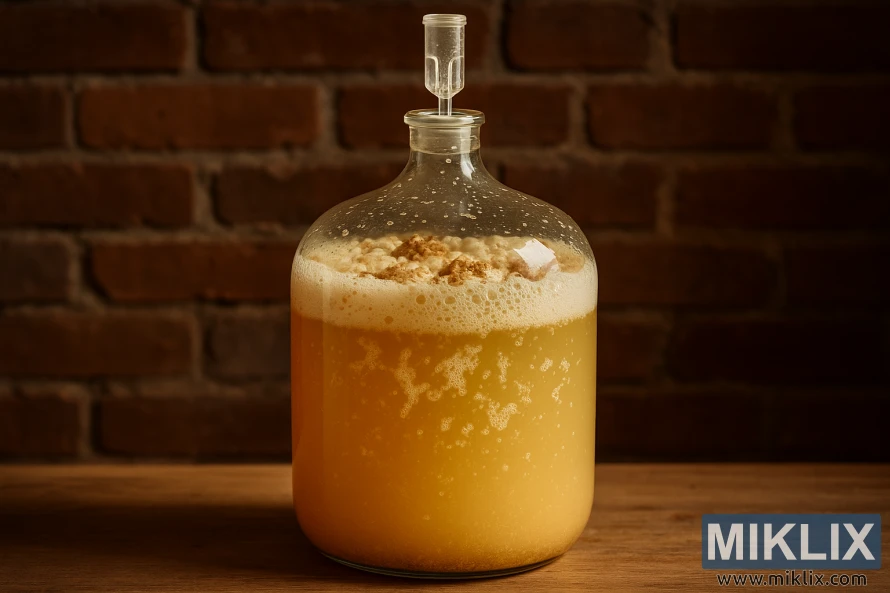Image: Active Hefeweizen Fermentation in Glass Carboy
Published: November 9, 2025 at 12:14:10 AM UTC
High-resolution photo of a traditional hefeweizen beer fermenting in a glass vessel, showing thick foam, active yeast activity, and warm brewery ambiance.
This high-resolution photograph captures the intimate, dynamic moment of an active fermentation process inside a large glass carboy, used for crafting a traditional German-style Hefeweizen beer. The scene is warmly lit, evoking the comforting, artisanal atmosphere of a small brewery or homebrewing setup. The carboy, made of clear, thick glass, dominates the foreground. It stands upon a smooth wooden surface, whose honey-toned grain harmonizes with the amber and golden hues of the fermenting beer. Behind it, a rustic red brick wall serves as a textured backdrop, absorbing and diffusing the soft ambient light to create a sense of depth and quiet warmth.
The vessel itself contains the cloudy, opaque Hefeweizen wort, rich with suspended yeast and proteins that lend it a dense, hazy appearance typical of the style. The beer’s color transitions from a deep, turbid orange-gold at the base to a paler, more luminous yellow near the frothy head. This natural gradient hints at convection currents within the fermenting liquid, driven by the ongoing activity of the yeast.
At the top of the liquid, a thick layer of foam — the krausen — has formed, signaling vigorous fermentation. The krausen is composed of tan and white bubbles of varying sizes, some glossy and wet, others beginning to dry and form small islands of pale, crusted foam. Intermixed with these bubbles are specks and streaks of hop residue, yeast, and proteins clinging to the interior walls of the glass, forming organic patterns that mark the fermentation’s intensity. Through the translucent foam, one can glimpse pockets of rising bubbles, evidence of carbon dioxide being released as the yeast consumes sugars in the wort.
Atop the carboy is a small, transparent plastic airlock, an essential component of the fermentation process. This airlock allows CO₂ to escape safely without admitting external air, maintaining the anaerobic environment crucial for clean yeast performance. Tiny bubbles can be seen trapped within the airlock’s curved chamber, catching the warm light as they rise and burst, a visual indicator of the beer’s living transformation beneath.
The photograph’s composition emphasizes contrast between the organic and the engineered: the wild, unpredictable patterns of foam and fermentation juxtaposed with the precise, laboratory-like clarity of the glass vessel. The lighting — diffuse but rich, perhaps from a single soft source — enhances the tactile quality of the scene. Highlights on the glass curve gently around the vessel, while subtle reflections of the brick wall lend the image depth and realism.
This image captures not just a brewing process but an aesthetic moment of creation — the intersection of biology, chemistry, and craftsmanship. It celebrates the living nature of beer fermentation, a process both ancient and scientific, where yeast transforms humble grain into something complex and alive. The warm tones and serene stillness of the surrounding environment contrast beautifully with the internal motion of the fermenting liquid, making this not just a technical documentation of brewing but a visual homage to the art of fermentation itself.
The image is related to: Fermenting Beer with Bulldog B49 Bavarian Wheat Yeast

